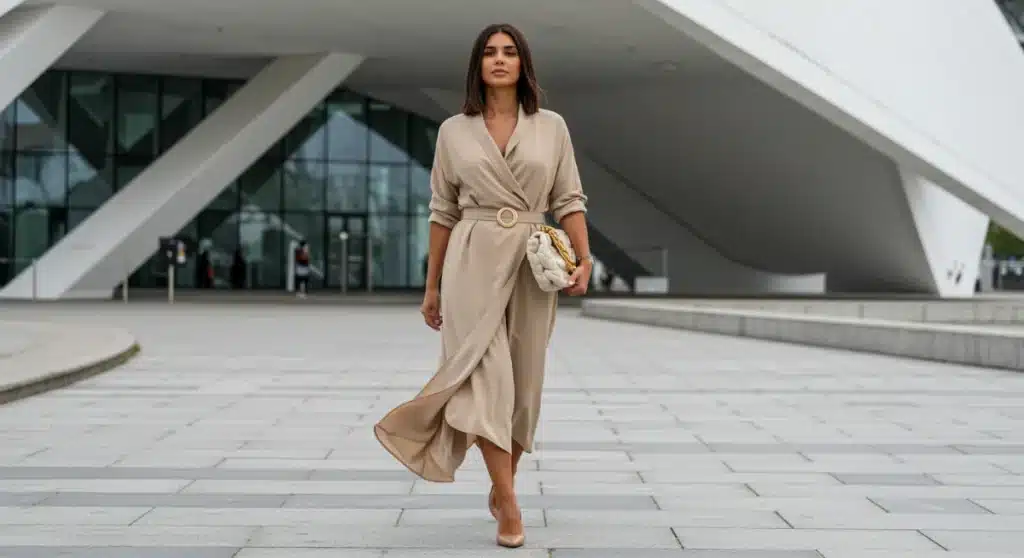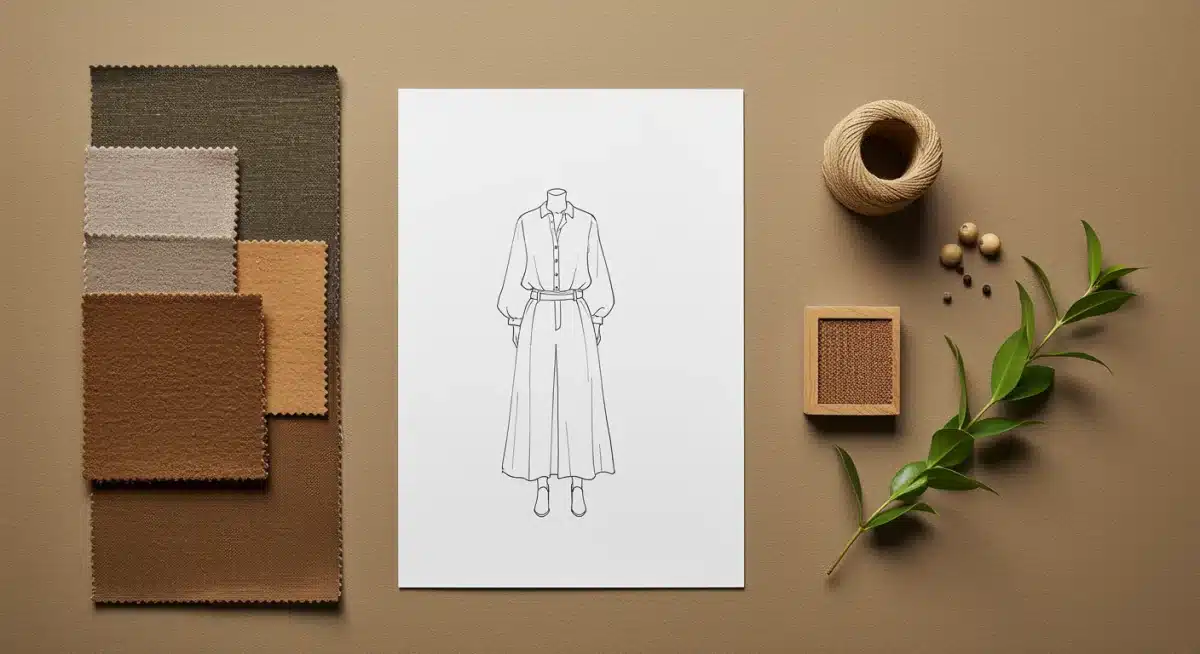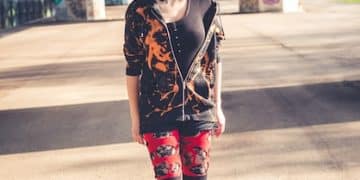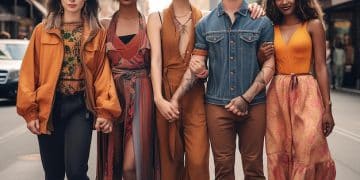The 2025 Style Guide: 7 Essential Trends for a Modern Wardrobe

The 2025 style guide for a modern wardrobe focuses on integrating comfort, advanced technology, and sustainable practices, promoting versatility and individual expression through curated essential trends.
Navigating the ever-evolving world of fashion can be daunting, but understanding upcoming trends is key to a sophisticated wardrobe. This exclusive look into the 2025 style guide reveals seven essential trends poised to redefine modern dressing, offering insider knowledge to elevate your personal style.
The Rise of Conscious Consumption and Sustainable Chic
In 2025, fashion is more than just aesthetics; it’s a statement about our values. Conscious consumption has moved from a niche concept to a mainstream imperative, influencing how we shop, wear, and dispose of our clothing. Consumers are increasingly demanding transparency and ethical practices from brands, leading to a significant shift in production and design philosophies. This trend is not merely about eco-friendly materials but encompasses the entire lifecycle of a garment, from sourcing to end-of-life.
The movement towards sustainable chic emphasizes quality over quantity, encouraging investment in durable, timeless pieces that transcend fleeting trends. It’s about building a wardrobe that minimizes environmental impact while maximizing style and versatility. This approach often involves innovative materials and production methods that reduce waste and conserve resources, without compromising on elegance or comfort.
Innovative materials and ethical production
The backbone of conscious consumption lies in material innovation. Designers are increasingly experimenting with textiles derived from recycled plastics, organic fibers, and even agricultural waste. These materials not only reduce environmental strain but also offer unique textures and properties that add a fresh dimension to fashion.
- Recycled Synthetics: Polyester and nylon derived from ocean plastics or post-consumer waste.
- Organic Cottons and Linens: Grown without harmful pesticides, ensuring a gentler footprint.
- Bio-based Fabrics: Materials like Tencel, derived from wood pulp, known for their softness and durability.
- Upcycled and Repurposed textiles: Giving new life to existing fabrics and garments, reducing landfill waste.
Ethical production, meanwhile, focuses on fair labor practices and safe working conditions. Brands committed to sustainability are often transparent about their supply chains, ensuring that every hand involved in creating a garment is treated with respect and paid fairly. This holistic approach resonates deeply with consumers who seek to align their purchasing power with their personal ethics.
Ultimately, conscious consumption and sustainable chic are transforming the fashion landscape, pushing designers and consumers alike towards a more responsible and thoughtful engagement with clothing. It’s about creating a modern wardrobe that looks good and does good, reflecting a deeper understanding of our interconnected world.
Fluid Silhouettes and Gender-Neutral Designs
The boundaries of traditional gendered clothing are dissolving, paving the way for fluid silhouettes and gender-neutral designs that prioritize comfort, versatility, and individual expression. This trend is a natural evolution of broader societal shifts towards inclusivity and self-definition, where clothing serves as a canvas for identity rather than a rigid set of rules.
Fluid silhouettes feature relaxed fits, draping fabrics, and adaptable designs that can be worn by anyone, regardless of gender. Think oversized blazers, wide-leg trousers, and flowing tunics that offer freedom of movement and a sophisticated, understated elegance. The emphasis is on comfort without sacrificing style, creating pieces that are both practical and aesthetically pleasing.
Redefining traditional menswear and womenswear
Designers are actively challenging the historical distinctions between menswear and womenswear, creating collections that blur these lines. This doesn’t mean simply making women’s clothes larger or men’s clothes smaller; it involves a fundamental rethinking of form, function, and aesthetic. The goal is to create garments that are universally appealing and adaptable.
- Oversized Tailoring: Blazers and coats with generous cuts that offer a relaxed yet polished look.
- Draped Fabrics: Soft, flowing materials like silk, modal, and cupro that create elegant, non-restrictive forms.
- Versatile Separates: Pieces like button-down shirts, trousers, and knitwear designed to be styled in multiple ways across different body types.
- Minimalist Aesthetics: Clean lines and neutral color palettes that enhance the adaptable nature of the garments.
The impact of this trend is significant, offering consumers more choices and encouraging a more experimental approach to personal style. It fosters a sense of liberation from conventional fashion norms, allowing individuals to curate wardrobes that truly reflect their authentic selves. The rise of fluid silhouettes and gender-neutral designs marks a powerful step towards a more inclusive and expressive fashion future.
Technological Integration: Smart Fabrics and Wearable Tech
The intersection of fashion and technology is creating a new frontier in wardrobe essentials, with smart fabrics and wearable tech becoming increasingly integrated into everyday attire. This trend goes beyond mere aesthetics, offering functional benefits that enhance comfort, convenience, and even health monitoring. Imagine clothing that adapts to temperature changes, tracks your fitness, or even charges your devices.
Smart fabrics are engineered with advanced properties, such as moisture-wicking capabilities, UV protection, and even self-cleaning features. These innovations are transforming activewear, casual clothing, and even professional attire, making garments more durable, comfortable, and intelligent. The goal is to create clothing that works harder for the wearer, simplifying daily routines and improving overall well-being.
Innovations in functional apparel
Wearable technology, once confined to gadgets, is now seamlessly woven into the very fabric of our clothes. This integration is opening up exciting possibilities for personal monitoring and interaction with our environment. From garments embedded with biometric sensors to accessories that offer touch-free controls, the future of fashion is undeniably high-tech.
- Temperature-Regulating Fabrics: Materials that respond to body temperature, keeping you cool or warm as needed.
- Biometric Monitoring: Clothing with embedded sensors to track heart rate, sleep patterns, and activity levels.
- Integrated Charging: Garments with discreet pockets or panels that can wirelessly charge smartphones or other devices.
- Interactive Textiles: Fabrics that can change color, display patterns, or even respond to touch through embedded LEDs or micro-sensors.
The appeal of technological integration lies in its ability to blend practicality with cutting-edge design. It’s about creating garments that are not only stylish but also incredibly functional, offering a glimpse into a future where our clothes play an active role in our daily lives. As these technologies become more sophisticated and accessible, they will undoubtedly become a cornerstone of the modern wardrobe.
The Return of Maximalism with Thoughtful Curation
While minimalism has held sway for years, 2025 sees the triumphant return of maximalism, but with a crucial twist: thoughtful curation. This isn’t about haphazard clutter; it’s a deliberate, artful accumulation of bold prints, rich textures, and vibrant colors, all chosen with intention and personal narrative in mind. The new maximalism celebrates individuality and self-expression, making every outfit a statement.
This trend encourages mixing and matching unexpected elements, creating ensembles that are visually engaging and deeply personal. It’s about embracing the joy of dressing up, experimenting with layers, and playing with proportions. However, the key differentiator from past maximalist eras is the emphasis on quality and purpose. Each piece should tell a story or contribute meaningfully to the overall aesthetic, avoiding gratuitous excess.

Layering textures and bold patterns
Thoughtful maximalism thrives on the interplay of different textures and patterns. Imagine combining a chunky knit sweater with a silk skirt, or a tweed jacket over a floral dress. The contrast creates visual interest and depth, making the outfit dynamic and unique. Bold patterns, from abstract art to revived vintage motifs, are central to this aesthetic, used strategically to create focal points.
- Eclectic Prints: Mixing different patterns, such as stripes with florals or geometrics with animal prints, for a daring look.
- Rich Textures: Incorporating materials like velvet, brocade, faux fur, and leather to add tactile dimension.
- Vibrant Color Palettes: Experimenting with unexpected color combinations and bold hues to make a statement.
- Statement Accessories: Oversized jewelry, embellished bags, and unique headwear that complement and complete the maximalist vision.
The essence of thoughtful maximalism lies in its ability to be both extravagant and refined. It’s a trend that invites creativity and encourages wearers to express their personality without reservation, proving that more can indeed be more when approached with a discerning eye and a clear vision. This curated approach ensures that maximalism remains chic and sophisticated, rather than overwhelming.
The Revival of Timeless Classics with a Modern Twist
Fashion is cyclical, and 2025 sees a strong revival of timeless classics, but not without a contemporary update. This trend celebrates the enduring appeal of iconic garments while infusing them with modern sensibilities through innovative cuts, unexpected fabrics, and fresh styling. It’s about honoring heritage while embracing the future, creating a wardrobe that is both nostalgic and forward-thinking.
Think trench coats with exaggerated collars, tailored suits in unexpected hues, or classic denim reimagined with sustainable washes and unique embellishments. The objective is to take foundational pieces that have stood the test of time and give them a new lease on life, ensuring they remain relevant and exciting for the modern wearer. This approach offers a sense of familiarity combined with novelty, making it accessible yet intriguing.
Reimagining iconic garments
The beauty of this trend lies in its ability to bridge different eras of fashion. Designers are drawing inspiration from vintage archives but applying 21st-century techniques and perspectives. This results in pieces that feel both familiar and entirely fresh, offering a sophisticated blend of old and new. The focus is on subtle refinements that elevate the classic without losing its original charm.
- Updated Tailoring: Classic blazers and trousers with relaxed silhouettes or unexpected details like cut-outs.
- Innovative Denim: Vintage-inspired jeans with advanced sustainable washes or unique patchwork designs.
- Elevated Knitwear: Traditional sweaters and cardigans crafted from luxurious, eco-friendly yarns with modern fits.
- Refreshed Outerwear: Iconic coats and jackets featuring contemporary hardware, bold linings, or novel fabric combinations.
This revival of timeless classics with a modern twist is perfect for those who appreciate enduring style but also desire a touch of contemporary flair. It encourages building a versatile wardrobe around foundational pieces that can be easily updated with current accessories or styled in novel ways, ensuring longevity and adaptability in an ever-changing fashion landscape.
Comfort-Driven Elegance: Loungewear as Outerwear
The lines between loungewear and outerwear continue to blur in 2025, giving rise to comfort-driven elegance. This trend prioritizes ease and relaxation without sacrificing sophistication, making soft, luxurious fabrics and relaxed silhouettes acceptable for a wider range of occasions. It’s a direct response to a lifestyle that increasingly values comfort and versatility, especially as work and leisure spaces intertwine.
This isn’t just about wearing sweatpants outside; it’s about elevating casual pieces to a level of chic appropriate for public wear. Think beautifully tailored knit sets, cashmere joggers paired with silk blouses, or elegant tracksuits designed with refined details. The key is in the quality of the materials and the thoughtfulness of the design, transforming what was once strictly indoor attire into stylish, adaptable ensembles.
Elevating casual attire
The essence of comfort-driven elegance lies in its ability to make you feel as good as you look. Fabrics play a crucial role, with an emphasis on soft, breathable, and luxurious materials that drape beautifully and feel pleasant against the skin. The silhouettes are often relaxed but structured enough to maintain a polished appearance, ensuring that comfort never looks sloppy.
- Luxurious Knit Sets: Matching sweaters and skirts or trousers in fine gauge merino wool or cashmere.
- Silk and Satin Ensembles: Co-ord sets in fluid, lustrous fabrics that can be dressed up or down.
- Tailored Joggers: Trousers with elasticated waists and cuffs, crafted from sophisticated fabrics like crepe or wool blends.
- Elevated Hoodies and Sweatshirts: Made from premium cottons or blends, with subtle details like embroidery or unique cuts.
Comfort-driven elegance redefines what it means to be well-dressed, proving that style and ease can coexist harmoniously. It encourages a more relaxed yet refined approach to fashion, allowing individuals to move seamlessly from a cozy morning at home to an elegant evening out, all while feeling supremely comfortable and effortlessly chic. This trend is a testament to a lifestyle that values both well-being and impeccable taste.
Personalized Expression through Bespoke Details
In an era of mass production, the desire for uniqueness and individuality has led to a surge in personalized expression through bespoke details. 2025 emphasizes customization, allowing individuals to infuse their wardrobe with unique touches that reflect their personality, values, and story. This trend moves away from generic fashion, advocating for pieces that are truly one-of-a-kind and deeply meaningful.
Bespoke details can range from custom embroidery and hand-painted motifs to unique fabric choices and personalized hardware. It’s about collaborating with artisans or designers to create garments that fit perfectly and tell a personal narrative. This approach not only results in distinctive clothing but also fosters a deeper connection between the wearer and their wardrobe, promoting longevity and cherished pieces.
Craftsmanship and individuality
The focus on craftsmanship is paramount in this trend. It celebrates the skill and artistry involved in creating personalized items, from intricate stitching to custom-designed prints. This also extends to the choice of materials, with many opting for ethically sourced or rare fabrics that add to the exclusivity of the piece. The goal is to create heirlooms, not just garments.
- Custom Embroidery: Adding monograms, meaningful symbols, or personalized artwork to clothing.
- Hand-Painted Garments: Unique designs applied directly to fabric, making each piece an individual work of art.
- Bespoke Tailoring: Garments custom-made to exact measurements and design preferences, ensuring a perfect fit and unique style.
- Upcycled with Personal Touches: Transforming existing garments with new embellishments, patches, or alterations that reflect individual taste.
Personalized expression through bespoke details offers a refreshing antidote to fast fashion, emphasizing quality, artistry, and individuality. It allows individuals to become co-creators of their style, investing in pieces that resonate deeply with who they are. This trend not only elevates personal style but also supports skilled craftsmanship and sustainable practices, making it a powerful force in the future of fashion.
| Key Trend | Brief Description |
|---|---|
| Conscious Consumption | Focus on sustainable, ethical fashion choices and quality over quantity. |
| Fluid Silhouettes | Gender-neutral designs with relaxed fits and draping fabrics for inclusivity. |
| Smart Fabrics | Integration of technology for enhanced functionality and comfort in apparel. |
| Maximalism with Curation | Bold prints and textures chosen with intention, reflecting personal narrative. |
Frequently Asked Questions About 2025 Style Trends
The overarching theme for the 2025 style guide is a blend of conscious consumption, comfort-driven elegance, and personalized expression. It emphasizes sustainability, versatility, and individuality, moving away from fast fashion towards more thoughtful and functional wardrobes.
Sustainability is a core pillar, driving trends like ethical production, the use of recycled and bio-based fabrics, and a focus on durability. Consumers are increasingly seeking transparent brands committed to reducing environmental impact and promoting fair labor practices throughout their supply chains.
Absolutely. Gender-neutral designs and fluid silhouettes are more relevant than ever. They promote inclusivity and self-expression, offering relaxed fits and adaptable styles that transcend traditional gender norms, allowing individuals to wear what truly reflects their identity.
Technology is increasingly integrated into fashion through smart fabrics and wearable tech. This includes materials with temperature regulation, biometric sensors for health monitoring, and even integrated charging capabilities, enhancing both the functionality and convenience of clothing.
Thoughtful maximalism involves curating bold prints, rich textures, and vibrant colors with intention. Focus on quality pieces that tell a story, experiment with layering, and use statement accessories to create visually engaging and deeply personal ensembles without overwhelming your look.
Embracing the Future of Fashion
As we delve deeper into 2025, the fashion landscape is clearly defined by a dynamic interplay of innovation, responsibility, and personal touch. The trends outlined in this guide – from conscious consumption and fluid silhouettes to technological integration and thoughtful maximalism – collectively paint a picture of a wardrobe that is both highly functional and profoundly expressive. It’s an invitation to embrace clothing that not only looks good but also aligns with our values and enhances our daily lives, proving that true style is a harmonious blend of aesthetics and ethics. By understanding and selectively adopting these essential trends, you can curate a modern wardrobe that is truly future-proof and uniquely yours.





